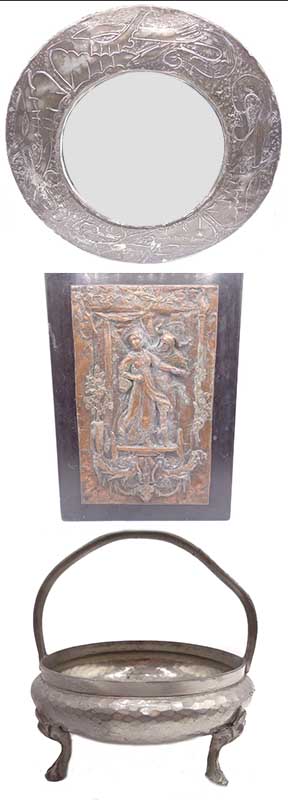
The Arts and Crafts movements emerged in the 1860s and lasted up until the first decades of the 20th century. Ideologically and stylistically, it was a continuation of the Aesthetic Movement but with an emphasis on traditional crafts. Thanks to the recognition of artisan skills and dedication to nature, Arts and Crafts antiques are the epitome of harmony, genuineness, and hand-craftsmanship.
The movement started as a reaction to the pretentious and ornate styles of the Victorian era. Criticizing machine-made products and exaggerated decor, Arts and Crafts put the beauty of nature and the true value of handicrafts to the fore. The adherents of the movement glorified traditional manufacturing techniques believing that the replication of consumer goods destroyed their beauty and individuality.
The ultimate goal of the Arts and Crafts movement was to produce designs ‘by people and for people’. Its ideal was a harmonious living space that combined the creativity of nature and contribution from skilful craftspeople. By and large, the movement attempted to achieve its ideal by joint efforts of architects, artists, artisans, and designers.
Arts and Crafts Antiques In and Out

Arts and Crafts exteriors and interiors alike were simple yet beautiful. The buildings themselves were small but spacious and cosy, intended for middle-class individuals. Their designs contrasted with pompous aristocratic mansions of the Victorian era. The walls were built from cheap and time-tested local woods (walnut, oak, spruce, cedar, etc) while porch railings and decorative cornices could have more expensive mahogany at their core.
The interiors of such houses were consistent with the exteriors – simple, elegant, and functional. From the inside, the walls were sheathed with wooden boards and oftentimes complemented with wallpapers featuring large floral patterns. Interior designers didn’t hide the wood behind a coat of paint. Instead, they covered it with clear lacquer in order to highlight its natural texture.
Arts and Crafts furniture and furnishings matched the interior in their simplicity and unfussiness. If they carried carved images, those were leaves, flowers, and primitive patterns. Additionally, decorative designs could be seen on frames and hinges. The sets of furniture were reduced to what was necessary: a desk, a built-in bed, chairs, stools, a chest of drawers, a wardrobe, a round dining table, as well as a dresser with a mirror and a sideboard. Lighter and more mobile bookshelves replaced bulky bookcases. The furniture, just like the walls and floors, was made of local wood species finished with wax or varnish.
Prominent Features of Arts and Crafts Antiques

If you take a close look at Arts and Crafts antiques, you are sure to notice some of these distinctive features:
• Uniform patterns pervasive throughout the entire interior – wallpaper, textile, friezes, etc. The decor was based on stylized images of leaves, fruits, birds, and other natural motifs. The late Arts and Crafts period, which arrived at the turn of the 20th century, saw a shift from floral patterns to abstract shapes as well as mythological themes. Ceramics by William de Morgan, porcelain by Walter Crane, as well as vibrant enamelled metalwork by Charles Ashby showcase these elegant designs.
• Japanese culture as a source of inspiration. The so-called Japanism, as it were, had two dimensions. On the one hand, artisans emulated Japanese motifs including birds, landscapes, flowers, seasons, etc. One of the most prominent admirers of Japanese artistic vision was Tiffany Studio, which incorporated Oriental imagery into their stained glass products. On the other hand, Japanese culture enriched Arts and Crafts items with such virtues as modularity, perfect balance, as well as simplicity with an emphasis on geometry.
• Respectful nods to Gothic and Medieval designs. Advocates of the Arts and Crafts movement admired the medieval period as the heyday of the guilds. Their goal was to revive the guilds’ approach to craftsmanship (hence, the movement is often called the guild revival). According to the movement’s principles, every item should be made by the same artisan from the ground up. At the same time, Arts and Crafts tried to repeat statement features of Gothic designs, in particular, heraldic motifs, embroidery, carvings, fretwork, pointed silhouettes, etc.
• Colour solutions based on the natural palette. Both exteriors and interiors were steeped in earth tones, for instance, the colour of tree bark, clay, leaves, grass, etc. Any colour that didn’t belong to the earthy palette (such as blue or pink) was either pale or muddy.
• Home décor items use natural and inexpensive materials. Local and exotic woods (bamboo, for example), ceramics, textiles (especially for upholstery, pillows, curtains, carpets, and tapestries), as well as items made of bronze, brass, and copper are fundamental materials of the style.
Arts and Crafts Antique Jewellery
The Arts and Crafts movement tried to blur the lines between architecture, crafts, furniture manufacturing, etc. Instead, it encouraged creative individuals to learn skills uncharacteristic of their field of expertise. For example, architects became furniture designers, and furniture designers mastered jewellery making. They pursued two goals: to bring complete harmony to the world of objects and reduce the cost of end products. Due to this ubiquitous skill exchange practice, many pieces of Arts and Crafts jewellery were delivered by people who weren’t jewellers by trade.
To make jewellery accessible to the middle class, it was crafted from inexpensive materials such as silver, copper, aluminium, steel, etc. Even if a piece featured gold, it was only a supporting accent. As for gemstones, the most popular choices included turquoise, moonstone, opal, garnet, opal, amethyst, and other non- and semi-precious minerals. Paying tribute to medieval styles, Arts and Crafts artisans cut gems en cabochons (domed shape and smooth surface). Faceted cutting deemed ‘unnatural’. The desired natural look was inherent in the so-called baroque pearls. Large and irregular in shape, they became one the most common inlays in the Arts and Crafts antique jewellery.
In an attempt to sing handicraft’s praises, jewellery makers deliberately focused on irregularities and roughness. Their favourite finishing technique was hammering producing small dents and subdued sheen as opposed to smooth radiant finishes made by machines.
Arts & Crafts Enamel
The hallmark of the Arts and Crafts antiques, along with Art Nouveau style flourishing during the same period, was enamel. Craftsmen often combined it with foliate motifs, and their interpretations were so unique that we are able to identify a specific manufacturer. For example, the pieces produced by Liberty are known for concave leave designs covered with clear enamel.
Necklaces are probably the most popular pieces of this design period. Very often, they featured a chain and pendant embellished with enamel or cabochon stone. Another common design was a dog collar paired with a medallion. Bracelets displayed similar styles and components including chains, round pendants, and ribbons. Earrings were not in vogue in the late 19th – early 20th centuries, so very few examples survived to this day.
Although Arts and Crafts adherents focused on the beauty of things, practicality was their number one priority. In addition to purely decorative necklaces and rings, the movement gave its signature features to practical items such as buttons, clasps, shoe and belt buckles, etc. While the Edwardian style, which coincided with the Arts and Crafts movement, celebrated diamond tiaras as jewellery for the wealthy, the middle class opted for ivory combs as their go-to hair accessories.
Despite the efforts to make Arts and Crafts products available to the masses, their cost was still significantly higher than that of machine-made counterparts. Therefore, even before the outbreak of the First World War, the movement lost its momentum and it was soon replaced by modern style.
